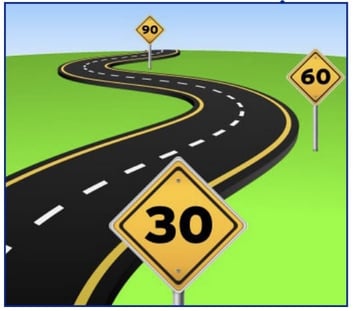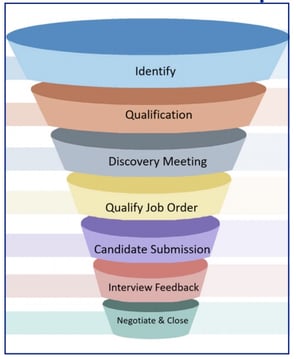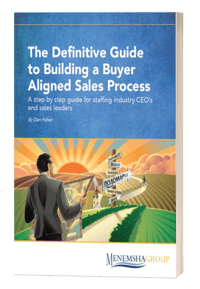The Definitive Guide to Building a Buyer Aligned Sales Process
A step by step guide for staffing industry CEOs and sales leaders

-
Table of Contents
- Introduction
- Sales Process Overview
- Sales Process Vs Sales Methodology
- The Reality for Most Staffing Firms
- The Value of Sales Process
- Five Benefits of Following a Sales Process
- Elements of Your Sales Process
- Building Your Buyer Aligned Sales Process
- Interviewing Your Ideal Target Customers
- Collaborate with Your Top Performers
- Define Seller's Sales Activities
- Define the Buyer's Activities
- Define Your Sales Process Lifecycle Stage Using Verifiable Outcome
Introduction
The most successful companies to emerge over the past twenty years have demonstrated that repeatable and sustainable growth is all about possessing the capability to scale. These companies have proven that by building a scalable growth model, significant profit margins can be generated without the burden of traditional overhead and budgetary restraints that stunt the growth of traditional, linear growth models.
A business with a highly scalable growth model is one that can grow exponentially without being weighed down by the same revenue to cost model associated with a linear growth model.
Instead, as sales revenues increase, costs remain relatively flat enabling higher profit margins. Highly scalable businesses can grow faster at higher profit margins and with less investment requirements, making them more efficient and more attractive to investors.
Many SaaS (Software-as-a-Service) companies, like HubSpot, Salesforce.com, Microsoft and Google have perfected the scalable growth model. Their initial costs for developing their platform or operating system is high, but once it is available for the market to consume, they can sign up users and grow revenue exponentially with relatively minimal cost increases thereafter.
But that is for software companies. How does a service provider such as a staffing and recruiting firm build a scalable model that can achieve repeatable, even predictable revenue growth?
Achieving scalable growth or “scalability” requires staffing firms to develop internal organizational systems including a buyer aligned sales process.
 By definition, a process is a systematic series of repeatable actions or steps intended to achieve a result. When followed, these steps lead to predictable and expected outcomes.
By definition, a process is a systematic series of repeatable actions or steps intended to achieve a result. When followed, these steps lead to predictable and expected outcomes.
A sales process defines the steps that a sales rep and the buyer need to take to complete the purchasing process, from lead, to opportunity, to close. It provides sales reps with a road map telling them exactly what they need to do next in order to advance the opportunity and eventually close the deal.
Anything that you do over and over again can be made more efficient and more effective by following a step by step process.
A documented sales process allows salespeople and sales managers to identify, qualify, diagnose, and measure opportunities and then determine the next step in the sales process.
It also enables sales managers and sales reps to quickly and easily identify bottlenecks including skill deficiencies with executing their sales process and make the necessary adjustments.
Your sales process should provide you, your manager, and your customer with a road map highlighting what needs to be completed and by whom to move your opportunity or job order down the proverbial sales funnel.
Sales efforts that are executed without a well defined series of steps or actions will lead to unpredictable sales forecasts and unfavorable results.
Before we get too deep in the weeds on sales process, it is important we clarify the difference between a sales process and a sales methodology.
Sales Process
A sales process defines the steps that a sales rep and the buyer needs to take to complete the purchasing process, from lead, to opportunity, to close. A sales process provides sellers with a road map telling them exactly what the buyer needs to do next in their buyer process and what selling activities the sales rep needs to complete in order to compel the buyer to complete the next step in their buying process.
Sales Methodology
A sales methodology describes how you execute each step within your sales process. Your sales methodology details how a sales rep will compel the prospect to take action and move from one stage of the sales process to the next. The table below provides more details on the differences between a sales process and a sales methodology.

Most staffing organizations invest heavily in Applicant Tracking Systems (ATS) and/or Customer Relationship Management (CRM) software with the expectation that the software is the sales process. Unfortunately, this strategy and investment rarely translates into field adoption, resulting in unpredictable and unfavorable results.
Having a standardized sales process adds structure and accountability to your sales activities, leading to a higher win rate and shorter sales cycles.
The cornerstone of a good sales process is defined by knowing and aligning with how your buyers buy, rather than with how sellers prefer to sell.
Studies have shown that following a sales process will help you win more deals, increase your deal size, and win deals faster with more frequency.
One key to an effective sales process is designing it in such a way that it keeps you in sync with your buyer throughout their buying journey and purchasing process. Not only does this ensure you keep your buyer’s needs front and center across all touch points, but it enables you to create a memorable and valuable customer experience.
If you and your manager fail to understand and define how your buyers buy than you will have nothing to discuss and you end up just pitching your service. Misalignment with buyers is a critical and a common mistake you need to avoid.
Sales organizations that apply inconsistent behaviors and follow a haphazard sales process produce inconsistent and unpredictable results. It clouds their sales funnel and sales forecast. It’s akin to putting a sales team in a big boat and everyone starts rowing in a different direction; paddling hard but going nowhere.
Following a sales process enables sales professionals and sales managers to enjoy the following benefits:
1. Leverage a common framework for planning, reviewing, and executing your sales activities
2. Use a common language to communicate with your team members to strategize on sales opportunities
3. Make fewer mistakes because you’re reminded of the steps that you and your customer must complete. This will shorten your sales cycle because you will be able to work through the steps faster when they’re all laid out in advance instead of “winging it”
4. Accelerate ramp up and time to quota attainment with new hires
 Your sales process should account for the following:
Your sales process should account for the following:
1. The steps and activities sellers must complete to identify, qualify and convert new accounts, new contacts, and new sales opportunities.
2. When in the sales process you qualify accounts, contacts, and job orders to determine if they are worth your time
3. How your customers select and engage staffing firms
4. How your customers hire and procure IT consultants (your candidates)
5. How you close business
There are five steps to building your buyer aligned sales process and they include:
1. Interviewing your ideal target customers
2. Collaborating with your top sales performers
3. Defining the sellers sales activities
4. Defining the buyer’s buying activities
5. Defining sales process lifecycle stages using verifiable outcomes
 Building and adopting a buyer aligned sales process accounts for the fact that different buyer types buy differently, and that sales professionals must be aware of and adjust their approach accordingly. To that end, the first step in building a buyer aligned sales process begins by interviewing your ideal target customers.
Building and adopting a buyer aligned sales process accounts for the fact that different buyer types buy differently, and that sales professionals must be aware of and adjust their approach accordingly. To that end, the first step in building a buyer aligned sales process begins by interviewing your ideal target customers.
Your ideal target customers could be IT hiring managers, Human Resources’s professionals or Procurement professionals. In fact, your ideal target customers could be all three, depending on the services that you sell.
Whomever your ideal customers are, you will need to interview them to uncover the specific steps and tasks that they must complete, and the decisions that they must make in order to buy your services.
This includes understanding their budget approval and funding process, their legal and contract approval process, and any other approvals and decisions that must be completed before they can purchase your services and hire your candidates. You should be able to assemble all of this information and sequence it into a timeline of events.
As a general rule, each ideal target customer persona will generally have the same buying process.
For example, if you sell primarily to Procurement professionals, than in general whenever selling to Procurement professionals, their process for how they buy from you will be the same from company to company. There will be some nuances but in general, it will be the same.
However, if you also sell to IT hiring managers than the sales process will be different than if you were selling to Procurement. You want to map out a buyer aligned sales process based on how each of your different ideal target customers buy.
You do NOT want to have one common sales process for all buyer types since they all buy slightly differently.
Finally, if you sell multiple products or services than you will likely need to map out a unique sales process for each. Your customers may not follow the same buying process for each service or product you sell.
After you interview your ideal target buyers and understand their buying process your next step is to collaborate with your top sales performers. You want them to walk you through step by step how they opened their three most lucrative accounts.
Don’t skip over the details. Find out exactly who they spoke with, what they said, what questions they had to answer, what information they had to provide and what steps their customer had to take including all stakeholders involved and the decisions they had to make.
Most importantly, be sure to uncover how and why these customers arrived at selecting your service over the competition. You should be able to assemble all of this information and sequence it into a timeline of steps and activities.
Once you have uncovered how your top sales performers closed their most lucrative accounts, it is time to define the seller’s sales activities. Defining the seller’s sales activities simply means uncovering the tasks and activities that the seller must complete in order for the customer to proceed in their buying process.
Sample sales activities include:
- Educate the buyer on relevant industry trends
- Establish credibility • Use personalized messaging
- Share relevant customer case studies
- Sign the customer’s NDA
- Deliver a proposal or presentation that addresses the customer’s needs
Once you have uncovered how your ideal target customers evaluate and procure staffing services, it is time to document all of the steps and activities that your customers must complete in order to buy from you.
Common buyer activities include:
- Experience symptoms of problem (your solution can resolve)
- Conduct research to resolve the problem
- Consider potential solutions
- Shop and compare vendors
- Conduct an ROI analysis
- Gain buy-in from other stakeholders
- Review proposals
- Conduct vendor references
Sales process lifecycle stages are designed to help you organize your opportunities based on where the customer and seller reside within the sales process.
A verifiable outcome is an observable, verifiable fact that proves that the seller has successfully completed a step in the sales process.
Think of verifiable outcomes as stage specific exit criteria; they tell the salesperson they have successfully completed a step in the sales process and are now ready to move to the next stage of the sales process.
There are two two types of verifiable outcomes: Sales Driven Verifiable Outcomes, and Customer Driven Verifiable Outcomes.
Sales Driven Verifiable Outcomes
Sales driven verifiable outcomes are based on observable and verifiable tasks, activities and/or artifacts that the salesperson completes or produces. Customer driven verifiable outcomes are based on observable and verifiable tasks, activities and artifacts that the customer completes and/or produces.
For example, the first step in your sales process may be “Deal Identified.” The verifiable outcome that proves whether or not the salesperson has successfully completed the Deal Identified stage might be:
1. The customer verbally shared their pain points or problem(s) to be solved
2. The customer verbally shared their level of commitment and interest in taking action to solve the problem(s)
3. The customer verbally indicated to the salesperson that they want the salesperson’s help and that their offering could be the right solution to solving their problem(s)
Keep in mind that this does NOT imply the opportunity is qualified but simply that a potential opportunity exists. In this case we refer to these verifiable outcome as a customer driven verifiable outcomes because it is the customer who produces the verifiable outcome by verbally sharing this information with the salesperson.
Each stage of the sales process is aligned with how your customers buy.
This means you will rely on customer driven verifiable outcomes for telling the seller whether or not they have successfully completed each step of their buying process.
One of the biggest benefits of having a buyer aligned sales process is that it keeps sellers aligned with their buyers regarding the things they must do in order to buy from them.
The application of customer driven verifiable outcomes allows sellers to test whether or not the customer is moving along with the seller in the process because customer driven verifiable outcomes are observable, verifiable facts that proves that the customer is moving along and executing the steps in their buying process. An example of this might be signing your NDA, agreeing to a discovery meeting or committing to candidate interview times.
Without applying verifiable outcomes, sales professionals would be stuck with relying on gut instinct which leads to making incorrect assumptions, lost opportunities and an inaccurate sales forecast.
Download your personal copy of this eBook by completing the form to the right.

Customer Driven Verifiable Outcomes
Want to learn more about how our training solutions can help your IT staffing firm gain a competitive advantage? Download our free ebook, The Ultimate IT Staffing Training Solution.




